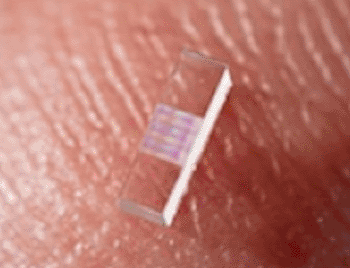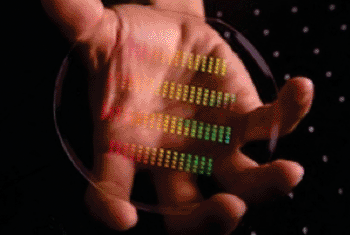Accelerator-on-a-Chip Designed for Medical, Research Applications
By LabMedica International staff writers
Posted on 14 Oct 2013
A new technologic achievement could drastically downsize particle accelerators for medical and science applications. Researchers are now using a laser to accelerate electrons at 10 times the rate of higher than traditional technology in a nanostructured glass chip smaller than one grain of rice. Posted on 14 Oct 2013
The project was reported September 27, 2013, in the journal Nature by a group including scientists from the US Department of Energy’s (DOE) SLAC National Accelerator Laboratory and Stanford University (Menlo Park, CA, USA). “We still have a number of challenges before this technology becomes practical for real-world use, but eventually it would substantially reduce the size and cost of future high-energy particle colliders for exploring the world of fundamental particles and forces,” said Dr. Joel England, the SLAC physicist who led the research. “It could also help enable compact accelerators and X-ray devices for security scanning, medical therapy, and imaging, and research in biology and materials science.”
Because it employs commercial lasers and low-cost, mass-production technology, the researchers believe it will set the stage for new generations of “tabletop” accelerators. At its full potential, the new “accelerator on-a-chip” could equal the accelerating ability of SLAC’s 3.22-km-long linear accelerator in only 30.5 m, and deliver one million more electron pulses per second.
This first demonstration achieved an acceleration gradient, or amount of energy gained per length, of 300 million electron volts per meter. That is about 10 times the acceleration provided by the current SLAC linear accelerator. “Our ultimate goal for this structure is one billion electron volts per meter, and we’re already one-third of the way in our first experiment,” said Stanford Prof. Robert Byer, the lead investigator for this research.
Currently used accelerators employ microwaves to enhance the energy of electrons. Scientists have been searching for more cost-effective options, and this new technique, which uses ultrafast lasers to propel the accelerator, is a leading candidate. Particles are typically accelerated in two stages. They are first boosted to nearly the speed of light. Then any further acceleration increases their energy, but not their speed; this is the problematic part.
In the accelerator-on-a-chip experiments, electrons are first accelerated to near light-speed in a conventional accelerator. Then they are focused into a tiny, half-micron-high channel within a fused silica glass chip just half a millimeter long. The channel had been patterned with specifically positioned nanoscale ridges. Infrared laser light shining on the pattern generates electrical fields that interact with the electrons in the channel to boost their energy. Turning the accelerator-on-a-chip into an actual tabletop accelerator will require a more compact approach to boost the electrons’ speed before they enter the device.
A collaborating research group in Germany, led by Peter Hommelhoff at Friedrich Alexander University (Nürnberg) and the Max Planck Institute of Quantum Optics (Garching), has been looking for such a solution. It simultaneously reported its effectiveness in using a laser to accelerate lower-energy electrons.
Applications for these new particle accelerators would go way beyond particle physics research. Prof. Byer noted that laser accelerators could drive compact X-ray-free electron lasers, comparable to SLAC’s Linac Coherent Light Source, which can become all-purpose tools for a wide range of research.
Another possible application is small, portable X-ray sources to enhance healthcare for individuals with war injuries, as well as provide more cost-effective medical imaging for hospitals and laboratories.
Related Links:
SLAC National Accelerator Laboratory and Stanford University













 Analyzer.jpg)




